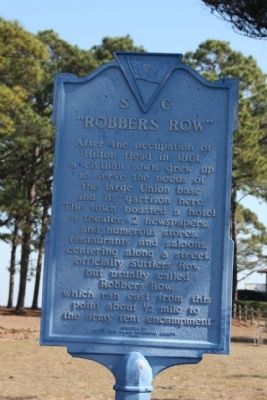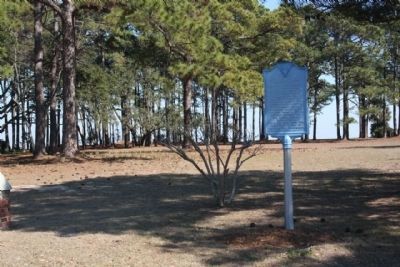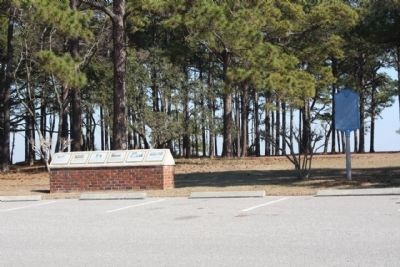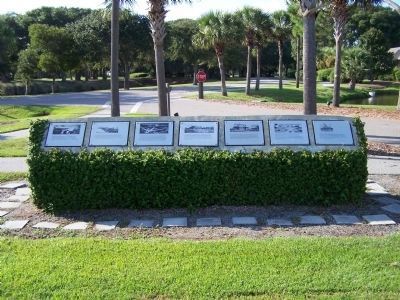Hilton Head Island in Beaufort County, South Carolina — The American South (South Atlantic)
"Robbers Row"
Erected 1961 by Hilton Head Island Historical Society. (Marker Number 7-6.)
Topics. This historical marker is listed in this topic list: War, US Civil.
Location. 32° 13.952′ N, 80° 40.632′ W. Marker is on Hilton Head Island, South Carolina, in Beaufort County. Marker is on Fort Walker Drive, on the right when traveling north. Between N. Port Royal Dr. & Steam Gun Place - Port Royal Plantation - a Secure Gated Community, Restricted access. Touch for map. Marker is in this post office area: Hilton Head Island SC 29928, United States of America. Touch for directions.
Other nearby markers. At least 8 other markers are within walking distance of this marker. Fort Walker (a few steps from this marker); Hilton Head (approx. 0.2 miles away); Two Gallant Gentlemen from South Carolina (approx. 0.2 miles away); Battle of Port Royal (approx. 0.2 miles away); Steam Gun (approx. 0.2 miles away); The Dawn of Freedom: Mitchelville (approx. 0.6 miles away); The Battle of Port Royal / William Fitzhugh and Black Sailors in the Union Navy (approx. 0.6 miles away); Black Troops on Hilton Head (approx. 0.6 miles away). Touch for a list and map of all markers in Hilton Head Island.
Regarding "Robbers Row". Port Royal Plantation's golf course is cut through beautiful stands of magnolias and live oaks. Rich in history,set atop former Civil War grounds on the marsh side of the plantation.
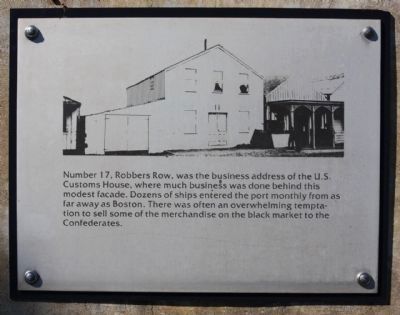
Photographed By Mike Stroud, February 2009
4. "Robbers Row"
Number 17, Robbers Row, was the business
address of the U.S. Customs House,
where much business was done
behind this modest facade. Dozens of
ships entered the port monthly from
as far away as Boston. There was often
an overwhelming temptetion to sell
some of the merchandise on the black
market to the Confederates.
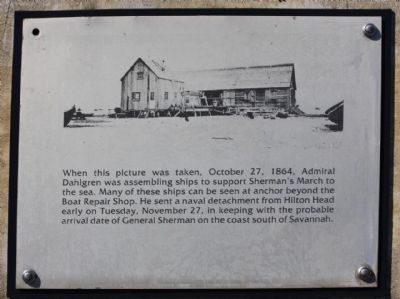
Photographed By Mike Stroud, February 2009
5. "Robbers Row" , Boat Repair Shop
When this picture was taken, October 27,
1854, Admiral Dahlgren was assembling
ships to support Sherman's March to
the sea. Many of these ships can be seen
at anchor beyond the Boat Repair Shop.
He sent a naval detachment from Hilton
Head early on Tuesday, November 27, in
keeping with the probable arrival date
of General Sherman on the coast south
of Savannah.
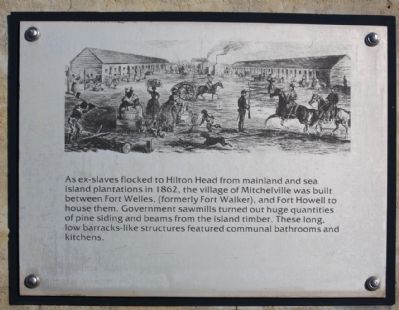
Photographed By Mike Stroud, February 2009
6. "Robbers Row" Quarters
As ex-slaves flocked to Hilton Head from
mainland and sea island plantations in
1862, the village of Mitchelville was
built between Fort Welles, ( formerly
Fort Walker ), and Fort Howell to house
them. Government sawmills turned
huge quantities of pine siding and beams
from the island timber. These long, low
barracks-like structures featured
communal bathrooms and
kitchens.
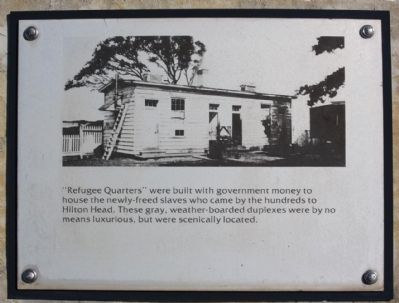
Photographed By Mike Stroud, February 2009
7. "Robbers Row" Interpretive Marker , "Rufugee Quarters"
"Rufugee Quarters" were built with
Government money to house the
newly-freed slaves who came by the
hundreds to Hilton Head. These gray,
weather-boarded duplexes were by no
means luxurious, but were scenically
located.
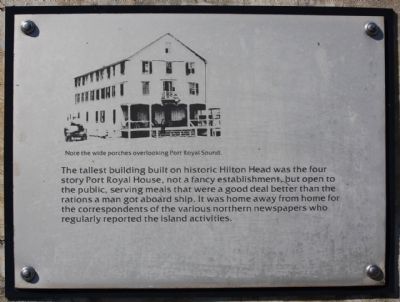
Photographed By Mike Stroud, February 2009
8. "Robbers Row" , Port Royal House
Note the wide porches overlooking Port Royal Sound
The tallest building on historic Hilton Head was the four story Port Royal House, not a fancy establishment, but open to the public, serving meals that were a good deal better than the rations a man got aboard ship. It was home away from home for the correspondents of the various northern newspapers who regularly reported the island activities.
The tallest building on historic Hilton Head was the four story Port Royal House, not a fancy establishment, but open to the public, serving meals that were a good deal better than the rations a man got aboard ship. It was home away from home for the correspondents of the various northern newspapers who regularly reported the island activities.
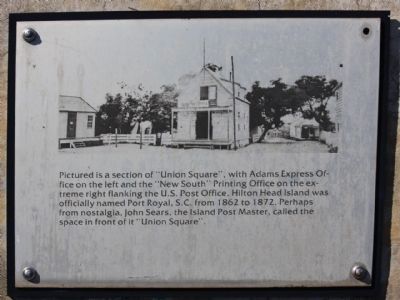
Photographed By Mike Stroud, February 2009
9. "Robbers Row" Union Square Interpretive Marker
Pictured is a section of "Union Square",
with Adams Express Office on the left
and the "New South " Printing Office"
on the extreme right flanking the U.S.
Post Office. Hilton Head Island was
officially named Port Royal, S.C. from
1862 to 1872. Perhaps from nostalgia,
John Sears, the island Post Master,
called the space in front of it "Union
Square".
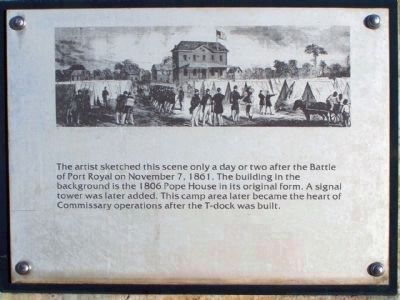
The Hilton Head Island Historical Society
10. "Robbers Row" Port Royal Interpretive Marker
The artist sketched this scene only a day or two after the Battle of Port Royal, November 7, 1861. The building in the background is the 1806 Pope House in its orininal form. A signal tower was later added. This camp area later became the heart of Commissary operations after the T-dock was built.
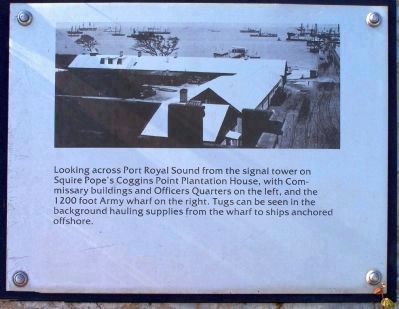
The Hilton Head Island Historical Society
11. "Robbers Row" Wharf, Port Royal Interpretive Marker
Looking across Port Royal Sound from the signal tower on Squire Pope's Coggins Point Plantation House, with
Commissary buildings and Officers Quarters on the left, and the 1200 foot Army wharf on the right. Tugs can be seen in the background hauling supplies from the wharf to ships anchored offshore.
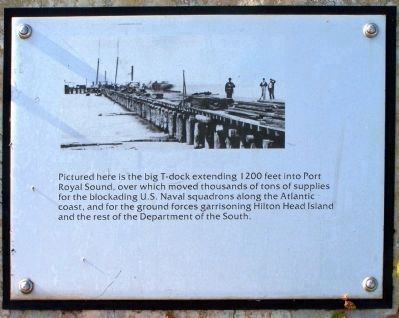
The Hilton Head Island Historical Society
12. "Robbers Row" T-dock Port Royal Interpretive Marker
Pictured here is the big T-dock extending 1200 feet into Port Royal Sound, over which moved thousands of tons of supplies for the blockading U.S. Naval squadrons along the Atlantic coast, and for the ground forces garrisoning Hilton Head Island and the rest of the Department of the South.
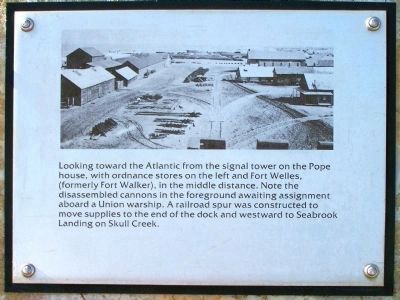
The Hilton Head Island Historical Society
13. "Robbers Row" Ordnance stores, Port Royal Interpretive Marker
Looking toward the Atlantic from the signal tower on the Pope house, with ordnance stores on the left and Fort Welles, (formerly, Fort Walker), in the middle distance. Note the disassembled cannons in the foreground awaiting assignment aboard a Union warship. A railroad spur was constructed to move supplies to the end of the dock and westward to Seabrook Landing on Skull Creek.
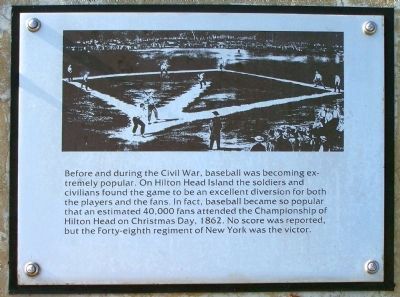
The Hilton Head Island Historical Society, `
14. "Robbers Row" Baseball, Port Royal Interpretive Marker
Before and during the Civil War, baseball was becoming extremely popular. On Hilton Head Island the soldiers and civilians found the game to be an excellent diversion for both players and the fans. In fact, baseball became so popular that an estimated 40,000 fans attended the Championship of Hilton Head on Christmas Day, 1862. No score was reported, but the Forty-eighth regiment of New York was the victor.
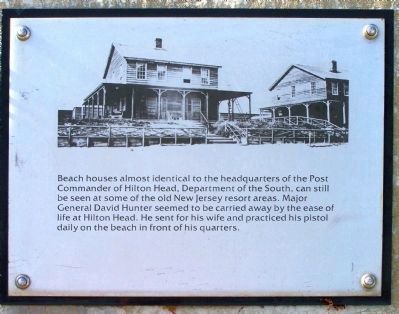
The Hilton Head Island Historical Society, `
15. "Robbers Row" Beach House, Port Royal Interpretive Marker
Beach houses almost identical to the headquarters of the Post Commander of Hilton Head, Department of the South, can still be seen at some old New Jersey resort areas. Major General David Hunter seemed to be carried away by the ease of life at Hilton Head. He sent for his wife and practiced his pistol daily on the beach in front of his quarters.
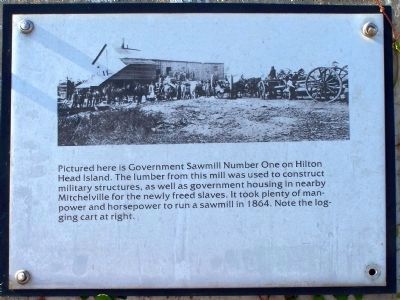
The Hilton Head Island Historical Society, `
16. "Robbers Row" Sawmill Number One, Port Royal Interpretive Marker
Pictured here is Goverment Sawmill Number One on Hilton Head Island. The lumber from this mill was used to construct military structures, as well as government housing in nearby Mitchelville for the newly freed slaves. It took plenty of manpower and horsepower to run a sawmill in 1864. Note the logging cart at the right.

The Hilton Head Island Historical Society, `
17. "Robbers Row" Ironclad "Atlanta" Port Royal Interpretive Marker
The Confederate ironclad, "Atlanta", seen here after her capture by Union forces, represented the last effort by the Confedercy to break the blockade of the Port of Savannah. Upon her surrender, two Federal vessels escorted her to Hilton Head where the survivors of her 165 man crew were put in the prisoners-of-war stockade, or if wounded, were
taken ashore to the 200 bed general hospital.
Credits. This page was last revised on June 16, 2016. It was originally submitted on March 1, 2009, by Mike Stroud of Bluffton, South Carolina. This page has been viewed 3,424 times since then and 43 times this year. Photos: 1, 2, 3, 4, 5, 6, 7, 8, 9. submitted on March 1, 2009, by Mike Stroud of Bluffton, South Carolina. 10, 11, 12, 13, 14, 15, 16, 17, 18. submitted on August 30, 2009, by Mike Stroud of Bluffton, South Carolina. • Craig Swain was the editor who published this page.
